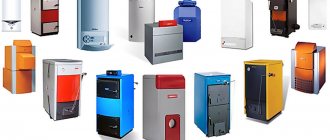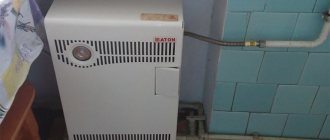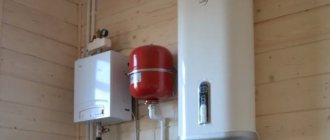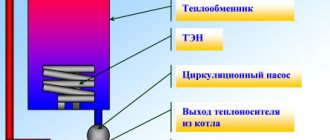- Difficulties in floor placement
In connection with universal gasification, cottage owners no longer need to purchase coal and firewood in advance, light the stove early in the morning and constantly monitor it so that it does not go out. If you have decided to make your life easier, collected all the papers, arranged a room for equipment, fulfilled all the requirements of the relevant services, there is only one thing left to do - buy a sufficiently powerful gas boiler, suitable for heating any private home, and determine which one is the best. This task, at first glance, is simple, but how comfortable your home will be depends on your preferences and wishes. If the model is not functional enough, you will have to overpay for the natural resource. Therefore, we will tell you what you need to focus on and what criteria to use when selecting a device. There are some standards by which you can decide on a product, based on operating conditions, climate zone, area, installation method and much more. We will give you some recommendations on how to purchase the heat generator that is most preferable to you.
Parameters for choosing the optimal gas boilers for different rooms and a private home
You will make a big mistake if you come to purchase and immediately buy the model you like in appearance. It is necessary to draw up a clear plan and act on it, without deviating from each stage.
Installation is directly dependent on the buyer completing the following operations:
- First, determine how much usable area needs to be heated, for example, heat not only into a residential building, but also into the adjacent garage, barn and greenhouse.
- The equipment can be floor-mounted or wall-mounted. Consider whether the household needs hot water. If yes, then you can purchase dual-circuit equipment with a liquid heater online.
- Take care of the future room for the coolant and determine its type - open (placed in a separate room with a window) or closed (can be placed in a kitchen drawer).
- If you want to buy a unit that is independent of energy (electricity), then you need to rely on the natural circulation of the coolant. And plan the entire scheme with this in mind.
- The level of automation is also important when choosing. Many models are equipped with modern functions: control via remote control, maintaining a set temperature according to a schedule, ensuring safety during operation, a built-in control system, and so on. In all cases, mechanisms must be installed to ensure that the supply is shut off in the event of combustion failure.
- And another important factor is cost. Estimate how much money you plan to spend on purchasing the installation.
After following our recommendations, contact your local gas company. The service often introduces its own restrictions, non-compliance with which can result in huge fines and difficulties with commissioning.
With two circuits
Double-circuit heat generators combine two devices at once: a water heater and a heating device. The water heater provides the house with hot water with connection to the DHW (hot water supply) system. When working to heat a home, the boiler functions in the same way as an instantaneous water heater.
Double-circuit units have two operating modes:
- heating the coolant in the heating system;
- heating water in the DHW system.
When the first mode is turned on, the gas burner operates until the coolant reaches the set temperature, then turns off. The coolant circulating in the system gives off heat, and when the temperature drops, the automation turns the burner on again.
In water heater mode, the gas is ignited at the moment the hot water tap is opened.
Determining the power of a gas appliance
This criterion is the most important, since it determines how efficiently you can heat your home.
You should know that the technical documentation indicates a specific parameter (nominal performance). In addition, the instructions provide recommendations for what area this model is designed for.
But it is better to entrust the final calculations to professionals.
The power of heating equipment directly depends on the thermal insulation properties of your home. It consists of:
- volume (space and ceiling height);
- compactness of the building (number of walls);
- specifics of the location and arrangement of windows and doors;
- location and insulation of unheated adjacent rooms (attic, basement, garage, etc.);
- climatic zone of the room (temperature, wind intensity, humidity).
Heating is greatly influenced by the number of window openings and the area of contact with the external environment. This calculation will be correct for the central strip and, accordingly, insulated walls. For hot water supply, the result obtained is multiplied by 1.2. In order not to put the power generator into the “overload” position, a coefficient of 1.3 is added. As a result, we should obtain the required productivity approximately twice as large as the minimum calculated threshold. We have provided you with an illustration for the cottage. For a building with several owners, the calculation method will be different from this.
On the Internet it is easy to find calculators for calculating the required heat transfer for different types of buildings. All of them, with one degree or another, allow you to determine what power you should install.
In any case, the results will be approximate, so it’s worth adding a performance margin of about twenty percent. We provide you with a video that clearly shows how to determine the required kilowatts yourself.
Smart electronics
You can choose a gas boiler for heating a private home with additional functions that, although they increase its cost, make operation safe and convenient:
- Flame sensor – turns off the gas supply independently if there is no flame;
- Blocking – the program turns off the boiler if the gas supply stops;
- Traction control sensor - ensures that carbon monoxide does not form so much that it becomes dangerous, and ensures that the device operates without accidents.
Nuances when choosing gas boilers for heating a private home
When you start looking for equipment, don’t look at the “promoted” brand and appearance. The main criteria are operational efficiency, functionality, production materials, type of arrangement, combustion chamber and ignition, and the number of coils in the heater.
Technical characteristics and raw materials used in production
If you decide to purchase a unit that supplies warm water, then you need to carefully study the design of the heat exchanger. Since there is a liquid constantly moving inside it, and outside it is affected by hot masses of high temperature. Thus, it is regularly exposed to continuous exposure to aggressive environments. Therefore, it is very important that manufacturers make the exchanger from materials that are not susceptible to corrosion. Common ones are cast iron, stainless steel and copper.
Let's look at the pros and cons of each of the three options.
As a rule, a cast iron heater, made from an alloy of iron and carbon, is one of the most durable and reliable. It is installed on floor-standing single-circuit boilers. On the other hand, the presence of graphite (approximately 2.3 percent) makes it brittle when handled carelessly during installation, mechanical shock and sudden temperature changes. In all cases, there is a possibility of cracks forming and further depressurization of the heat exchanger. It requires constant descaling.
The steel element is installed on almost all models, as it has a low cost. The impact resistance of the structure allows you to not be afraid during transportation and installation. Very easy to maintain, much easier to clean from carbon deposits. If cast iron cannot be welded with a welding machine, then steel can be restored, provided there is no global breakdown.
The disadvantage is fragility, because the material undergoes oxidation and, as a result, rust forms on it. In addition, thin material burns out after three to four years.
Boilers with a copper heat exchanger are a prestigious product, since their price is much higher than their counterparts with steel or cast iron elements. Copper has high heat transfer characteristics and therefore responds instantly to rising temperatures, which leads to significant fuel savings. Even if errors were made during installation (distortion of pipes), the material prevents water from boiling, as it ensures good circulation of liquid.
The internal design of the coil can be single-circuit or double-circuit. The second option is made from a pair of conventional heat exchangers or one bithermal one.
Location
In stores selling gas equipment you will be offered two types of devices: floor-mounted or wall-mounted. Please note that the second type is not very powerful. For a small house or one-room apartment, a model that is placed on a vertical surface is sufficient.
Consider one more nuance when choosing. Think about how often the electricity goes out in your area. After all, wall-mounted units are energy-dependent, and in the event of a power surge or an accident, you will be forced to sit without heat for a long time. So for a country house, the best option is to install a floor-standing device. In case of force majeure, you will be sure that your unit will work even without supervision and you will not arrive at “cold” batteries.
Number of circuits
Good inexpensive gas boilers for heating apartments and private houses are available with one or two coils.
If it is enough for you to warm up the building and use hot water in containers of different volumes, then a single-circuit heating device is suitable for these purposes. The relevant services give their permission to connect the pipe from the device to the liquid boiler. But you should know that most of the energy will be used for heating. This product is convenient for a small family of two or three people, for arranging summer cottages.
If, during the construction of a two-story building, you plan to install heated floors, then in this case it is necessary to install a double-circuit boiler. When you turn on your water system, your tap water will be heated online to the temperature you prefer. Please note that at this time the device’s energy will be directed only to heating the liquid, and not to heating the radiators.
Selection by combustion chamber, ignition type and burner
By combustion chamber:
- Open. Most devices fall into this class. Air for oxidation of incoming fuel is taken from the room due to supply ventilation.
- Closed. In cases where it is not possible to remove the chimney through the roof, manufacturers have found a way out by creating a structure where the necessary oxygen is supplied from the street through a double-circuit pipe - coaxial. In such a situation, forced exhaust of combustion products must be provided. The connection between the boiler and the external environment is achieved through a short pipe system.
All complex energy-dependent devices are equipped with electric ignition, which works like a spark plug in a car. This allows an autonomous restart without human intervention in case of an emergency. Your device will turn on after a short-term gas outage or power outage. A simpler design provides piezo ignition. In this version, a spark appears when pressed, like in a household lighter. The most primitive way is with an open fire. Such technologies are good for their energy independence, but in the event of a flame failure they do not turn on independently. If you have installed heating in your dacha, then if the fuel supply is temporarily turned off, the boiler will go out and there is a possibility that the pipes will defrost.
Subtleties of operation
For ease of use, modern equipment is equipped with various control systems. It is possible to set the desired temperature in the room air and hot water supply. Change the intensity according to the time of day, for example, set the heating to high power from morning to evening, and lower it at night. This will be done without your participation.
Safety presets are important. Automation turns off the mechanism in various emergency situations. Typically, all information appears on built-in or remote displays. They reflect both operating modes and fault codes in the event of a breakdown.
Popular manufacturing brands and their brief descriptions
Today you can purchase boiler equipment from a variety of manufacturers, both foreign and domestic.
When buying gas equipment, you need to pay attention to the presence of an automatic safety system . You should not skimp on the excellent quality of the device, because life and health are more valuable than any money. When purchasing a gas boiler, you need to study the terms of warranty service.
Our country is characterized by unstable operation of the gas network, low air temperatures, and poor water quality. When choosing a boiler, adapt it as much as possible to modern Russian conditions.
At the moment, the following manufacturers have proven themselves well in the market:
- Buderus and Viessmann . German companies that produce Premium class boilers are reliable, easy to use and install.
- Ariston, Hermann, Baxi (Italy), Electrolux (Sweden), Unitherm (Germany), Protherm Slovakia) . They produce middle-class equipment - not too expensive, not very prestigious, but quite high quality.
- Feroli, Neva Lux (Russia) . Budget class boilers, which have a shorter service life, but have affordable prices.
Which gas boilers are better for a private home (floor-mounted or wall-mounted)
The choice of design and power of your heating device will depend on several factors:
- required performance;
- installation locations;
- set of necessary options.
There are models on sale with a high level of automation, both mounted and floor-mounted. You can decide on the option based on the possibilities of constructing gas exhaust and ventilation systems. Non-volatile devices are always installed on the floor. This is due to the characteristics of the unit and the need to set the front point as low as possible. Otherwise, gravity heating will not function correctly.
Difficulties in floor placement
This installation allows cast iron heat exchangers not to fail. If you have determined the location of the boiler on the floor, then you are not limited in choosing a model by weight, dimensions, or combustion systems. Among other things, it is possible to equip the product with any type of automation.
Wall placement
This approach imposes quite a lot of restrictions. The design is always volatile with constant electricity consumption. But at the same time it does not take up much space, allowing for the removal of combustion products at minimal cost. It can even be placed inside furniture.
With condensate processing
Condensing gas units are a type of conventional convection boilers with increased energy efficiency. If we consider that the efficiency of a conventional gas boiler is about 90%, then 10% of the exhaust gases heated to a temperature of 150 to 250 degrees Celsius simply go down the chimney. In order to capture and remove heat from them to the smoke exhaust systems of condensing gas generators, additional heat exchangers are installed.
The process of condensation formation on secondary heat exchangers occurs quite efficiently, so they are most often made of chemical-corrosion-resistant stainless steel or silumin.
Our advice
Before making a decision, try to find out everything about gas boilers.
Decide what functions you need in their operation and indicate your preferred location. Be sure to coordinate all questions with the relevant services. There are strict technical regulations for the installation of all products.
To select a chimney, you can contact the manufacturing company FERRUM, which produces chimneys of all configurations, as well as tanks and heat exchangers.
Installation features
The connection diagram of heat generators depends on many factors. Some types of high-power equipment require an autonomous boiler room, while low-power heaters can be wall-mounted in the kitchen or utility room.
Gas equipment is a source of increased danger, therefore the installation of homemade gas burners and other elements in gas supply systems is prohibited. All gas heat generators of well-known brands undergo several stages of quality checks, and their installation should only be carried out by specially trained personnel.











